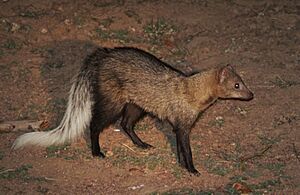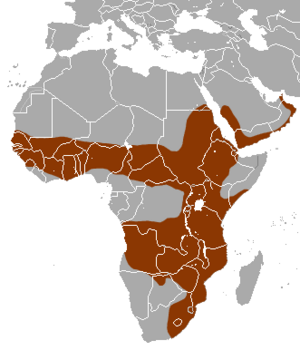White-tailed mongoose facts for kids
Quick facts for kids White-tailed mongoose |
|
|---|---|
 |
|
| Conservation status | |
| Scientific classification | |
| Genus: |
Ichneumia
|
| Species: |
albicauda
|
| Subspecies | |
|
|
 |
|
| range of the white-tailed mongoose | |
The white-tailed mongoose (Ichneumia albicauda) is a fascinating animal from the mongoose family. It's the only species in its group, called Ichneumia. These mongooses are known for their unique white tails, which make them easy to spot!
Contents
About the White-Tailed Mongoose
The white-tailed mongoose is the largest and heaviest type of mongoose. It can weigh between 1.8 and 5.2 kilograms (about 4 to 11.5 pounds). Its body, from head to tail, can be 53 to 71 centimeters (about 21 to 28 inches) long. The tail itself adds another 40 to 47 centimeters (about 16 to 18.5 inches)!
What Does It Look Like?
This mongoose has long legs, which are quite unusual for a mongoose. Its head is long and narrow, and it has big, round ears set low on its head.
Its fur is usually yellow or tan, mixed with long black hairs. This gives it a cool grizzled grey look. Its lower legs are black, and its large, bushy tail is brownish-yellow at the base. The end half of its tail is bright white, which is how it got its name! This white tail can be almost half as long as its body.
The white-tailed mongoose doesn't have hair on its upper lip or on its front paws. Female mongooses have four teats, which are used for feeding their young.
Where White-Tailed Mongooses Live
You can find white-tailed mongooses in most parts of Africa south of the Sahara Desert. They also live in the southern part of the Arabian Peninsula.
Their Favorite Places
These mongooses can live in many different places. They are found in dry areas like semi-deserts and grassy savanna woodlands. However, they avoid very wet places, like the Congo River basin. They also stay away from extremely dry deserts.
They really like areas with lots of hiding spots. This includes the edges of forests and bushy areas near streams. In some parts of Africa, like the East Sudanian Savanna, they have been seen in large protected areas.
How White-Tailed Mongooses Behave
White-tailed mongooses are mostly active at night. They are also terrestrial, meaning they live on the ground. During the day, they rest in safe places. These can be abandoned burrows, termite mounds, or holes under tree roots.
Home and Family Life
Each male mongoose has a home area of about 0.97 square kilometers (about 0.37 square miles). Females have slightly smaller areas, around 0.64 square kilometers (about 0.25 square miles). Male mongooses usually don't share their home areas with other males. However, a male's home area can overlap a lot with a female's area.
Females usually live alone with their babies. Sometimes, a few females and their young might share a small group, but they don't really hang out together. Even if they live in the same area, they go looking for food separately. They are mostly solitary animals, meaning they like to be alone. Males and females only come together to mate.
These mongooses don't travel far unless it's to find their own new territory away from their mother.
Sounds and Self-Defense
White-tailed mongooses are quite noisy! They make a unique barking sound. If they get scared, they can release a stinky liquid from special glands near their tail. Unlike some other mongooses, they don't stand on their hind legs for very long.
What White-Tailed Mongooses Eat
White-tailed mongooses mainly eat insects. However, they are not picky eaters and will enjoy many other foods too!
Favorite Foods
Their main diet includes:
They also eat:
They love to eat bird eggs. To open an egg, they cleverly throw it between their back legs against a rock or another hard object. Sometimes, they might even visit chicken coops in areas where people raise chickens!
Life Cycle and Reproduction
We don't know everything about how white-tailed mongooses reproduce. However, we do know some interesting facts.
When Babies Are Born
Most baby mongooses are seen between February and May. You won't see any young during the dry season, which is from August to November. This suggests that they probably only have babies once a year.
The young mongooses are fully weaned (meaning they stop drinking their mother's milk) when they are about nine months old. Around this time, they leave their mother to find their own territory. Scientists think that these mongooses become old enough to have their own babies before they turn two years old. The mother carries her babies for about 60 days before they are born.
The Name Game
The name Ichneumia comes from an old Greek word, ichneumon. This word means 'tracker'. It's interesting because the Egyptian mongoose also has a similar name, Herpestes ichneumon.
The species name, albicauda, tells us about its white tail. It comes from two Latin words:
- albus, which means 'white'
- cauda, which means 'tail'
Local Names
In the Tigrinya language, which is spoken in parts of Eritrea and Ethiopia, the white-tailed mongoose is called ፂሒራ (tsihira).


